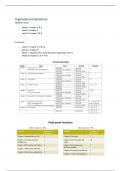Summary
Samenvatting Midterm & Endterm - Organizational Behavior, Global Edition - Organisational Behaviour (6011P0215Y)
- Course
- Institution
- Book
Based on the lectures, assignments and past exams. Contains the fabric of all weeks and is enriched with color coding and visual extras.
[Show more]




